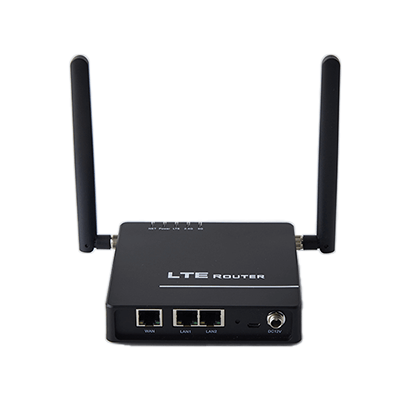What Is an M2M Router?

An M2M (machine to machine) router is a device that acts as a relay between devices and servers when various data collected by sensor devices at the end of the line are collected on servers for data processing.
For example, when multiple water level sensors are installed at multiple observation points to monitor the water levels of rivers and other bodies of water constantly, it is necessary to install wireless interfaces such as 3G and LTE to send data from the sensor devices to the server. As a result, each sensor device becomes very expensive.
M2M routers must be able to withstand a wide operating temperature range and be dustproof, as they will be used in harsh environmental conditions.
M2M Router Applications
M2M routers are used in a wide range of applications, including surveillance, equipment control in factories, disaster prevention, distribution warehouses, and agriculture.
1. Around and Inside Buildings
For surveillance applications, multiple cameras are installed around buildings in the city, condominiums, supermarkets, and even train stations, mainly for crime prevention purposes.
2. Factories
In factories, cameras are used to control various types of equipment, or to count and monitor the production status and number of products produced on production lines.
3. Logistics Warehouse
In distribution warehouses, M2M routers are used to check the availability, quantity, and management of inventory items.
Principle of M2M Routers
The basic operation of a system using an M2M Router is as follows:
1. Receive Data From Sensor Devices
An example of a surveillance application is a surveillance camera system installed in a city. Here, the surveillance camera serves as the sensor device, which has a built-in wireless interface such as Wi-Fi, and sends the camera images to the M2M router.
2. M2M Router Internal Processing
The M2M router receives camera images from multiple locations, compresses the image data and processes it into a data format that can be easily processed by the server side, along with data indicating image attributes. It then encrypts and protects the data, and transmits it to the server over 3G, LTE, or other lines.
After processing the data sent from the M2M router as necessary, the data is made ready for analysis and displayed on a display.
3. Receiving Data From the Server
The above is the flow of data transfer from the sensor device to the server side, but there is also a reverse direction. For example, when a suspicious person is found in the displayed surveillance image and further tracking is required.
Here, the surveillance camera on one of the sensor devices is oriented to track the suspicious person. To do this, the server will issue a “change direction” command to this surveillance camera. The command arrives at the M2M server via a line such as 3G or LTE.
Upon receiving this command, the M2M server identifies the camera(s) from which the server received the command from among multiple cameras, and forwards the command only to the camera(s) to which the command was sent. In this case, the commands are generally converted into commands that can be interpreted by the surveillance cameras.
When the camera receives the command sent from the server, it controls itself and changes the direction of the camera. In this way, the sensor device and the server communicate with each other via the M2M router.
Other Information on M2M Routers
1. Communication Protocols of M2M Router
An example of M2M communication is communication via the Internet using wireless communication means such as GSM, 3G, and LTE. These communication methods were originally used for human-to-human communication using mobile wireless communication networks. Later, they began to be used with the intention of expanding the market to include device-to-device communications.
M2M communications for device-to-device communications can be local, closed or wired communications in addition to the above communication methods. Considering cost and communication performance, communication between devices is realized by appropriately combining these various communication means.
2. Difference From IoT
IoT stands for “Internet of Things” and refers to the various objects in society that are connected to the Internet and can communicate with each other, etc. IoT is basically considered consisting of four components: data collection, data storage, data analysis, problem solving, and value creation. The difference between IoT and M2M is that IoT is connected to M2M.
The difference between IoT and M2M is in what it connects and how it connects: M2M refers to communication via the Internet, as well as direct machine-to-machine communication. On the other hand, IoT connects not only to machines but also to other devices and sometimes even to people.
Also, while the purpose of IoT is to collect and utilize information, the purpose of M2M is to collect information from and control machines. M2M is suitable when accurate information needs to be collected by sensors.